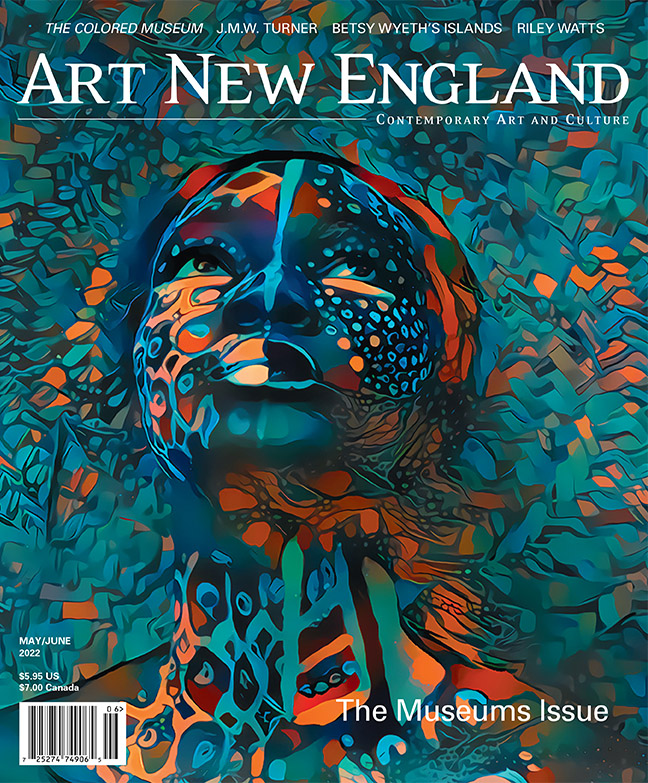From the Publisher – May 2022
Art New England’s May/June issue highlights museums. It’s a tradition that casts a light on what these places mean to us at a particular point in time. This is a difficult and painful political moment and I hope this issue offers a bit of solace while encouraging all of you to spend time in a museum. Big or small, stately or quirky (yes, there are quirky museums), it doesn’t matter. They offer respite, illumination, even a meditative place to be calm. To regroup amidst the chaos outside. To simply “be” in a space, alone or with friends, and witness, question, and revel in the works around you. Museums are accessible and I am sure there is one close to where you live.
This Museums Issue celebrates some of New England’s most provocative exhibitions. The issue came together, as most issues do, with an overall intention that meanders organically into a finished product. And yet—look at what we’re writing about: Images of Atheism: The Soviet Assault on Religion at the Museum of Russian Icons, eloquently analyzed by Kristin Nord. The story was planned before Putin’s invasion began, as was the J.M.W. Turner exhibition at the MFA where Christopher Volpe, with a passionate, earthy elegance, positions the show perfectly within the context of history and this moment. And while many of you may not be aware of the incredible work being done at The Umbrella Arts Center in Concord, MA, you will be now. It’s our cover, Nettrice Gaskins’s Sunset. Jennifer Mancuso writes about Umbrella’s upcoming theatrical production/art exhibition The Colored Museum and its creative forces. Hilary Irons immerses us into This Land: American Engagement with the Natural World at the Hood Museum, a multi-faceted exhibition with as much to teach about listening to the land as it does understanding our history. So powerful—all of them. Can’t be an accident that these exhibitions are all happening now. These museums are speaking to us, requesting our engagement in conversation. How fortunate are we to write about these places and these works, and to have the freedom to experience and discuss them without fear.
I am deeply outraged by Putin’s war on Ukraine. In a “don’t get me started” kind of way. Yet I want to make space for the conversation that’s happening on another level—that we are not at war with Russians, that we are not condemning the nation. Nor are we condemning Russian people living in the United States, Russian artists making work here, or Russian exhibitions that teach us about the history and influences that created its current culture.
I don’t always feel like I have a handle on everything. In these moments I reach out, ANE reaches out, for insight and perspective. ANE has been craving poetry and has found a new colleague in central Massachusetts, Maria Luisa Arroyo Cruzado, an assistant professor in writing and first-year studies at Bay Path College, and an esteemed poet. We asked her to speak to this moment and the role of art in these strained times. Her ghazal (“Originally an Arabic verse form dealing with loss and romantic love, medieval Persian poets embraced the ghazal, eventually making it their own. Consisting of syntactically and grammatically complete couplets, the form also has an intricate rhyme scheme”, as defined by the Poetry Foundation) and her voice is one we’ll turn to again.
Make space for museums, make space for tolerance and empathy in a moment where words like “annihilation,” “genocide,” “tactical nuclear weapons” and “the end of democracy” are spoken each day. Read a poem. And consider wearing your mask for a little while longer, just to be on the safe side.
Enjoy the issue,
Tim Montgomery
Publisher
P.S. I would also like to thank our readership for the many positive comments we’ve received regarding the uncoated stock in the March/April issue. While the paper crisis continues, please note that we may not know from issue to issue whether coated or uncoated stock is available. Once the paper market stabilizes, we’ll make a final decision.
Pandemic-fatigued, we poets turn to art in
these strained times.
Undigested in our guts, our words churn
for art in these strained times.
In 1965, Maria Prymachenko, you painted
a pretty cobalt pig, teats full,
munching on crimson berries. Let’s yearn
for art in these strained times!
Winter is wrestling wildly with Spring.
On April 10th, wind dragons rattle
the rafters, flip open the pages of my ANE.
I return to art in these strained times.
This is not how you celebrate Lent:
military assaults during a pandemic,
our prayers unheard. They burned
Prymachenko’s art in these strained times.
Dzvinia and Ali, as doulahs, you coax
Bilotserkivets’s poems of hope and sorrow
to breathe and live in English. Transmutation:
To learn art across these strained times.
Mass MoCA. The MFA. The Worcester Art
and Springfield Museums. Masked,
I seek solace and sanctuary, only concern
myself with art in these strained times.
—María Luisa Arroyo Cruzado

ON THE COVER: Nettrice Gaskins, Sunset, 2019, created using Deep Dream Generator, size is variable. Courtesy of the artist. This piece is part of The Colored Museum: Past, Present, Future gallery exhibit, curated by Cedric Vise1 Douglas at The Umbrella Arts Center, opening May 20. See page 34.
